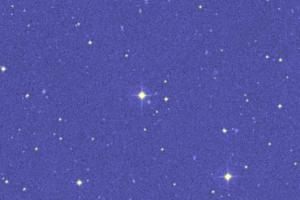Finding a planet that resembles the Earth is the ultimate goal of our exoplanetary explorations. It implies the possibility of life on a world not so different from our own, and encourages the speculation that Earth-like worlds are out there in huge numbers.
We certainly haven’t found such a place yet, but we’re getting closer. Which is why Gliese 876, a red dwarf some 15 light years from our Solar System, made news today at a National Science Foundation briefing. No planet yet found — and that includes roughly 155 extrasolar planets to date — is as similar to Earth as the one found here. Gliese 876 is in the direction of the constellation Aquarius, and it is known to possess two larger gas-giant worlds as well as this much smaller neighbor.
 Not that conditions on the newfound world would be exactly habitable by our standards. The planet, some seven and a half times the mass of Earth, orbits its host star once every 1.94 days, and it’s only two million miles from it (about one-tenth the size of Mercury’s orbit in our own Solar System). Its radius is about twice that of Earth.
Not that conditions on the newfound world would be exactly habitable by our standards. The planet, some seven and a half times the mass of Earth, orbits its host star once every 1.94 days, and it’s only two million miles from it (about one-tenth the size of Mercury’s orbit in our own Solar System). Its radius is about twice that of Earth.
Scientists working on the find estimate the planet’s surface is somewhere between 200 to 400 degrees Celsius (400 to 700 degrees Fahrenheit). Even so, that’s closer to an Earth-like world than what we’re used to finding; it’s certainly not a ‘hot Jupiter,’ and the fact that it is detectable at all tells us that we’ll soon be able to find even smaller rocky planets in the actual habitable zone of nearby stars.
“This is the smallest extrasolar planet yet detected and the first of a new class of rocky terrestrial planets,” said team member Paul Butler of the Carnegie Institution of Washington. “It’s like Earth’s bigger cousin.”
Image: Centered in this unremarkable, 1/4 degree wide patch of sky in the constellation Aquarius is the star Gliese 876. Gliese 876 is smaller than the Sun, only about 1/3 as massive, and too faint to be seen without a telescope. But it is known to be one of the nearest stars, only 15 light-years distant. Today’s announcement brings the number of known planets around this star to three. Credit: NASA/SkyView Digitized Sky Survey.
The first planet found around Gliese 876 was detected in 1998 by Butler and Geoff Marcy (University of California at Berkeley), who determined that it was a gas giant about twice the mass of Jupiter. Another planet was found in 2001, this one about half the mass of Jupiter. These two planets have been the subject of considerable scrutiny because they’re locked into resonant orbits, the outer planet orbiting the star in 60 days, which is twice the period of the inner planet. It was the study of this orbital resonance, much of it performed by Jack Lissauer (NASA Ames) and Eugenio Rivera (Lick Observatory) that led eventually to the discovery of the world announced today.
“We had a model for the two planets interacting with one another, but when we looked at the difference between the two-planet model and the actual data, we found a signature that could be interpreted as a third planet,” said Lissauer.
And here’s Gregory Laughlin of the Lick Observatory at the University of California, Santa Cruz:
“The planet’s mass could easily hold onto an atmosphere,” noted Laughlin, an assistant professor of astronomy at UC Santa Cruz. “It would still be considered a rocky planet, probably with an iron core and a silicon mantle. It could even have a dense steamy water layer. I think what we are seeing here is something that’s intermediate between a true terrestrial planet like the Earth and a hot version of the ice giants Uranus and Neptune.”
A paper detailing the results has been submitted to The Astrophysical Journal.

